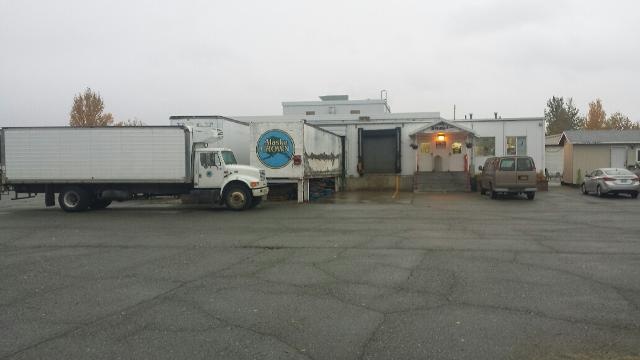Prison-run slaughterhouse faces budget ax, livestock growers rally
Prison-run slaughterhouse faces budget ax, livestock growers rally
Paula Dobbyn / KTUU
POSTED: 11:51 AM AKDT Oct 19, 2015 UPDATED: 12:11 PM AKDT Oct 19, 2015
5 / 5
A shot of the back of the Palmer slaughterhouse. Photo courtesy of Mike Nolan.
Alaska livestock growers are rallying to save a state-owned slaughterhouse operated with prison labor from closing next June.
Mt. McKinley Meats & Sausage is on the Legislature’s chopping block. A long-time money loser, the Palmer-based business is the only U.S. Department of Agriculture-certified slaughterhouse in Southcentral Alaska and if it closes, as planned, many farmers say they would be left without a convenient place to have their livestock butchered.
“My whole livelihood depends on it,” said Delta Junction cattleman Scott Mugrage, referring to the plant.
“I’m not comfortable with the fact that every year it’s been an item on the Legislature’s hit list. It’s really hard for a farmer, especially young people just starting out, to invest in this industry if the threat of shutdown is constantly looming,” Mugrage said.
The Alaska Farm Bureau, a group that promotes agriculture, recently hired two meat-industry consultants to take a look at the plant and make recommendations, said executive director Amy Seitz. The consultants wrote in an Oct. 9 report that the plant is well-maintained and designed. It’s a valuable and critical asset for Alaska’s food security, the consultants said, recommending that it remain in state ownership but be leased to a private entity that can run it more efficiently.
The report found that prison labor offers few advantages while “management salaries are crippling the plant."
Salaries and benefits total $363,486 for the plant’s three managers, according to a Department of Natural Resources report. These wages are "far and above what a meat plant manager would be paid at a comparable plant in the lower 48," consultant Mike Callicrate told KTUU.
"You can’t justify these wages," said Callicrate. "If you could get the salaries in line you could make the plant work."
Frank Huffman, one of the three plant managers, told KTUU that he had not read the report but he noted that besides his slaughterhouse duties, he’s also in charge of overseeing prisoners.
"Not only do we cut meat we do security for the inmates," Huffman said.
Huffman and production manager Jim Crigger have worked for the state for more than 20 years and have moved up through the pay scale, said Curt Sandvik, a Division of Agriculture manager.
The Alaska Legislature financed construction of the meat plant in the early 1980s to stimulate growth in the state’s agriculture industry. It operated privately from 1983 to 1985, according to Alaska Division of Agriculture. But the plant has always operated at a loss for the state.
“It’s lost money every year except in 2014 when it made a $43,000 profit,” said Sandvik.
DNR records show the plant lost $155,016 in the fiscal year ending June 30, 2015.
The state took over the slaughterhouse in 1986 after the previous owner defaulted on a loan. For many years, the Department of Corrections operated the plant for the Agriculture Division, using it as job-training opportunity for inmates.
Between 11 and 14 prisoners still work at the plant, under the supervision of three state employee managers, but the Department of Corrections no longer runs the slaughterhouse. The Division of Agriculture operates Mt. McKinley Meats and it’s financed through interest earned from the state’s Agricultural Revolving Loan Fund, said Franci Havemeister, director of the Division of Agriculture.
According to the most recent financial records, the meat plant took in $1.3 million in revenue between July 1, 2014 and April 30, 2015. Its expenses totaled $1.4 million, resulting in a $76,607 loss to date.
There’s little dispute that the slaughterhouse is money-loser but with low oil prices and the state facing a $3.5 billion budget deficit, calls for its shutdown are growing louder in the Legislature.
Last session, lawmakers approved a one-time cash infusion of just over $2 million for the plant, which will close at the end of June 2016 unless the Legislature changes direction, said Havemeister.
Sen. Bill Wilechowski (D-Anchorage) would like to see the slaughterhouse continue operating but he said it’s time for private management to take charge. Wielechowski is a member of the Senate finance subcommittee for natural resources.
The Alaska Farm Bureau’s livestock committee met Friday to review the consultants’ report. A majority on the committee agreed with the report’s recommendations that the state should retain ownership of the plant but that it be leased to a private entity, said Seitz.
Between now and the Farm Bureau’s annual meeting on Nov. 14, members will develop a transition proposal for the slaughterhouse, Seitz said, and then bring it before the Board of Agriculture and Conservation, a seven-member body appointed by the governor that oversees the revolving loan fund.
Even if the board approves a loan for a private entity to manage the plant, the Legislature will decide the meat plant’s fate because it controls state appropriations, said Havemeister.
Farmers like Mugrage are expected to lobby hard to keep the slaughterhouse alive. It’s a matter of economic survival for livestock growers as well as a food security issue for Alaska, argues Mugrage, president of the Delta chapter of the Alaska Farm Bureau.
“Only a tiny portion of the food we eat is grown here in Alaska," he said. "We’ve got about three days’ worth of food here in this state at any given time. If anything cuts off that supply line, we’re in trouble. Wouldn’t it be nice if we had some more of that food being raised here?
Copyright © 2015, KTUU-TV





